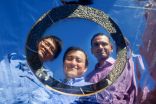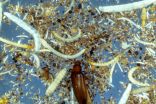(Press-News.org) Scientists investigating the potentially deadly hantavirus have used a novel approach to developing protective antibodies against it. Their work, published in today's online edition of Science Translational Medicine, provides proof of concept for producing antibodies against a broad range of human pathogens.
Hantaviruses cause a condition known as hantavirus pulmonary syndrome (HPS), which has a case fatality rate of 35-40 percent. Currently there are no licensed vaccines, prophylactics, or therapeutics to prevent or treat this highly pathogenic disease.
This research involved the use of specially bred "transchromosomal" cows that have been engineered to produce fully human antibodies. Investigators first immunized the cows with DNA vaccines targeting two types of hantaviruses, Andes virus and Sin Nombre virus. The team collected plasma from the cows, purified the human IgG antibodies, and tested the material for its ability to neutralize the two different viruses.
The purified human antibodies had "potent neutralizing activity against both hantaviruses," according to the paper's first author, Jay W. Hooper, Ph.D, of the U.S. Army Medical Research Institute of Infectious Diseases (USAMRIID).
To assess the efficacy of the antibodies, Hooper's team used a hamster model of Andes virus, the predominant cause of HPS in South America and the only hantavirus known to be transmitted person-to-person. Infection of Syrian hamsters with Andes virus, as demonstrated in earlier studies at USAMRIID, results in a disease that closely mimics human HPS in incubation time, symptoms of respiratory distress, and disease pathology. This makes it an ideal system for evaluating the feasibility of post-exposure protection strategies.
As described in the publication, seven of eight hamsters treated with the product survived with no signs of disease. In contrast, all eight hamsters treated with control human IgG purified from unvaccinated transchromosomal cows developed lethal HPS. Similar experiments were performed demonstrating that the purified human antibodies also protected immunosuppressed hamsters against lethal disease caused by Sin Nombre virus. This virus, which causes HPS in the US and Canada, has been associated with notable hantavirus outbreaks, including the cluster of cases at Yosemite National Park in 2012.
Recently, according to Hooper, scientists in Chile have had some success in using convalescent plasma from HPS survivors to treat the disease, which suggests that a polyclonal antibody approach to treatment is feasible. However, the immune plasma is in short supply and must be matched to each patient's blood type. The transchromosomal cows used by USAMRIID collaborator SAB Biotherapeutics, Inc. offer the opportunity to produce large quantities of antibodies that are fully "human," meaning they will not be seen as foreign antigen by the human immune system.
According to the authors, this is a significant advantage over other animal-derived polyclonal antibody approaches to the treatment of disease, where the antibody must be treated with enzymes to "despeciate" the antibodies to prevent a condition known as serum sickness. Moreover, it is possible that the human IgG will be capable of interacting with the human immune system to neutralize and clear virus in ways that despeciated antibodies cannot.
"This study represents the first time that DNA vaccines have been used to produce a hyperimmunized response in a human antibody-producing large animal species," said Eddie Sullivan, chief executive officer of SAB Biotherapeutics, Inc. "Furthermore, the animal studies show that the human antibody is protective in the animal model presented."
According to Sullivan, this technology can be used to rapidly respond to many types of diseases, as the development time from first vaccination to high-titer, fully human polyclonal antibody is just a few months. He added that each animal can produce up to several hundred or even a thousand human doses of antibody per month, making the platform very scalable, based on data from this and other studies.
"Monoclonal antibodies targeting infectious agents are most effective when combined into cocktails," said Hooper. "The transchromosomal cows allow us to rapidly produce large quantities of polyclonal antibodies that are, in effect, natural cocktails targeting specific threat agents like Andes virus and Sin Nombre virus."
Now that proof of concept has been demonstrated, Hooper said, the next step is to secure funding and approval for Phase I clinical trials in humans to assess the safety profile of the antibodies.
INFORMATION:
USAMRIID's mission is to provide leading edge medical capabilities to deter and defend against current and emerging biological threat agents. Research conducted at USAMRIID leads to medical solutions--vaccines, drugs, diagnostics, and information--that benefit both military personnel and civilians. The Institute plays a key role as a lead military medical research laboratory for lethal viruses for the Military Infectious Disease Research Program, and for the Defense Threat Reduction Agency's Joint Science and Technology Office for Chemical and Biological Defense. USAMRIID is a subordinate laboratory of the U.S. Army Medical Research and Materiel Command.
This news release is available in German.
Scientists led by Kristina Djinović-Carugo at the Max F. Perutz Laboratories (MFPL) of the University of Vienna and the Medical University of Vienna have elucidated the molecular structure and regulation of the essential muscle protein α-actinin. The new findings allow unprecedented insights into the protein's mode of action and its role in muscle disorders. The findings, made in collaboration with King's College London (KCL), may lead to improved treatments, and are published in the top-class journal Cell.
Most ...
A popular indigestion medication can increase survival in colorectal cancer, according to research published in ecancermedicalscience. But in fact, scientists have studied this for years - and a group of cancer advocates want to know why this research isn't more widely used.
"Cimetidine is an interesting drug as it's very safe, very well-known, and has clinical results in cancer that have been confirmed in a number of trials," says Pan Pantziarka, lead author of the paper and member of the Repurposing Drugs in Oncology (ReDO) project.
Cimetidine treats indigestion ...
Stanford engineers have invented a revolutionary coating material that can help cool buildings, even on sunny days, by radiating heat away from the buildings and sending it directly into space.
A team led by electrical engineering Professor Shanhui Fan and research associate Aaswath Raman reported this energy-saving breakthrough in the journal Nature.
The heart of the invention is an ultrathin, multilayered material that deals with light, both invisible and visible, in a new way.
Invisible light in the form of infrared radiation is one of the ways that all objects ...
A team of scientists, led by Dr Sebastian Hoenig from the University of Southampton, have developed a new way of measuring precise distances to galaxies tens of millions of light years away, using the W. M. Keck Observatory near the summit of Mauna Kea in Hawaii.
The method is similar to what land surveyors use on earth, by measuring the physical and angular, or 'apparent', size of a standard ruler in the galaxy, to calibrate the distance from this information.
The research, which is published in the journal Nature, was used to identify the accurate distance of the ...
One of the major problems in astronomy is measuring very large distances in the universe. The current most common methods measure relative distances, but now research from the Niels Bohr Institute demonstrates that precise distances can be measured using supermassive black holes. The results are published in the scientific journal, Nature.
The active galaxy NGC 4151 called the, 'Eye of Sauron' due to its similarity to the eye in the film Lord of the Rings, is a modest spiral galaxy. It has a supermassive black hole at its centre and this black hole is still active, that ...
BOSTON - A promising experimental immunotherapy drug works best in patients whose immune defenses initially rally to attack the cancer but then are stymied by a molecular brake that shuts down the response, according to a new study led by researchers at Dana-Farber Cancer Institute and the Yale University School of Medicine.
The antibody drug, known as MPDL3280A, inhibits the brake protein, PD-L1, reviving the response by immune killer T cells, which target and destroy the cancer cells. In recent clinical trials, the PD-L1 checkpoint blocker caused impressive shrinkage ...
MADISON, Wis. -- It was fishermen off the coast of Peru who first recognized the anomaly, hundreds of years ago. Every so often, their usually cold, nutrient-rich water would turn warm and the fish they depended on would disappear. Then there was the ceaseless rain.
They called it "El Nino," The Boy -- or Christmas Boy -- because of its timing near the holiday each time it returned, every three to seven years.
El Nino is not a contemporary phenomenon; it's long been the Earth's dominant source of year-to-year climate fluctuation. But as the climate warms and the feedbacks ...
A new study has pulled together research into the most diverse place on earth to demonstrate how the organisms below-ground could hold the key to understanding how the worlds ecosystems function and how they are responding to climate change.
Published in Nature, the paper by Professor Richard Bardgett from The University of Manchester and Professor Wim van der Putten of the Netherlands Institute of Ecology, brings together new knowledge on this previously neglected area. The paper not only highlights the sheer diversity of life that lives below-ground, but also how rapid ...
Scientists from Queen Mary University of London have made a breakthrough in developing a new therapy for advanced bladder cancer - for which there have been no major treatment advances in the past 30 years.
Published today in Nature, the study examined an antibody (MPDL3280A) which blocks a protein (PD-L1) thought to help cancer cells evade immune detection.
In a phase one, multi-centre international clinical trial, 68 patients with advanced bladder cancer (who had failed all other standard treatments such as chemotherapy) received MPDL3280A, a cancer immunotherapy ...
In the race to find materials of ever increasing thinness, surface area and conductivity to make better performing battery electrodes, a lump of clay might have just taken the lead. Materials scientists from Drexel University's College of Engineering invented the clay, which is both highly conductive and can easily be molded into a variety of shapes and sizes. It represents a turn away from the rather complicated and costly processing--currently used to make materials for lithium-ion batteries and supercapacitors--and toward one that looks a bit like rolling out cookie ...






